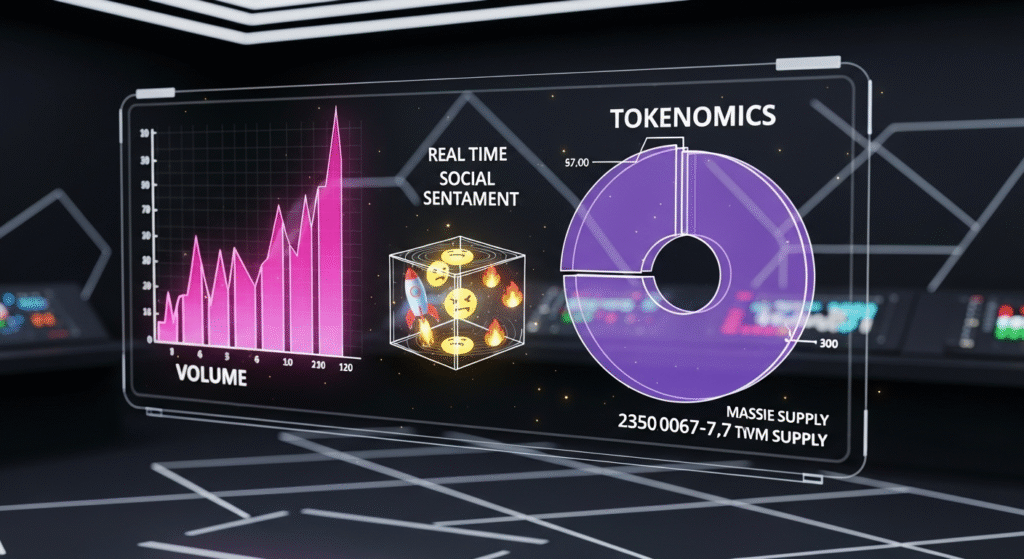Volatility Trading:
The cryptocurrency landscape is a whirlwind, and nowhere is this truer than in the frenetic world of meme coins. We’ve all seen the headlines: Dogecoin’s meteoric rise, Shiba Inu’s surprising ascent, and the countless smaller tokens that flicker into existence and vanish just as quickly. But behind the often-humorous branding and community hype, lies a complex dance of supply, demand, and… Volatility Trading. Can the average investor, perhaps even a curious newcomer drawn in by the promise of quick gains, truly navigate these choppy waters and emerge victorious? Or are meme coins just a casino in disguise? Understanding the fundamentals of Volatility Trading is not just advantageous; it’s the bedrock upon which any potential profit can be built..
Crypto Market Overview: Riding the Altcoin Tide
The crypto market in 2025 continues to be a dynamic beast, with Bitcoin and Ethereum often setting the pace, but the real excitement for many lies in the altcoins. We’re seeing a significant resurgence in interest, driven by technological innovation, institutional adoption, and the ever-present allure of outsized returns. Meme coins, while often dismissed by traditional finance circles, are undeniably a part of this altcoin ecosystem. Their performance is intrinsically linked to broader market sentiment, liquidity flows, and the innovative (or sometimes, simply viral) marketing strategies employed by their creators.
Key indicators to watch include the total cryptocurrency market cap, the dominance of Bitcoin and Ethereum (as their movements often signal shifts in altcoin investing), and the trading volumes across various exchanges. Recent months have shown a gradual recovery in altcoin markets, with many smaller cap tokens experiencing significant pump-and-dump cycles, creating fertile ground for astute Volatility Trading. Airdrop activity has also been a significant driver, with new projects distributing tokens to early adopters, often creating immediate trading opportunities.

The Core Concept: How Meme Coins and Altcoins Actually Work
To effectively engage in Volatility Trading, especially within the meme coin spectrum, a foundational understanding of what these assets are is crucial.
What Are Altcoins / Meme Coins / Airdrops?
- Altcoins: Short for “alternative coins,” altcoins represent every cryptocurrency other than Bitcoin. This is a vast category encompassing everything from established giants like Ethereum and Solana to thousands of smaller, niche tokens. They aim to improve upon Bitcoin’s design, offer new functionalities, or serve entirely different purposes.
- Meme Coins: A sub-category of altcoins, meme coins are cryptocurrencies that originated from internet memes, jokes, or social media trends. Their value is often driven more by community sentiment and speculative interest than by underlying technology or utility. Early examples like Dogecoin and later Shiba Inu gained massive popularity due to their viral nature and strong community backing.
- Airdrops: An airdrop is a marketing strategy used by cryptocurrency projects to distribute free tokens to their community. This is typically done to raise awareness, reward early supporters, or encourage network participation. For traders, airdrops can present an opportunity to acquire new tokens at zero cost, which can then be traded or held.
Key Components & Technologies
While meme coins may appear simplistic, they are built on the same fundamental blockchain technologies that power more established cryptocurrencies.
- Blockchain Technology: At their core, most altcoins and meme coins operate on a blockchain. This is a decentralized, distributed ledger that records all transactions across a network of computers. This distributed nature makes the ledger secure, transparent, and resistant to tampering. Different blockchains offer varying features, such as faster transaction speeds, lower fees, or more advanced smart contract capabilities.
- Smart Contracts: Many altcoins, particularly those built on platforms like Ethereum (ERC-20 tokens), utilize smart contracts. These are self-executing contracts with the terms of the agreement directly written into code. They automate processes and can underpin complex functionalities within a cryptocurrency project, from token distribution to decentralized finance (DeFi) applications.
- Consensus Mechanisms: Blockchains rely on consensus mechanisms (like Proof-of-Work or Proof-of-Stake) to validate transactions and secure the network. The choice of consensus mechanism impacts the blockchain’s speed, energy consumption, and decentralization, all of which can influence the value and usability of the tokens built upon it.
- Tokenomics: This refers to the economic design of a cryptocurrency token, including its supply, distribution, inflation/deflation mechanisms, and utility. For meme coins, tokenomics are often highly speculative, with large initial supplies and sometimes burning mechanisms designed to create scarcity and drive demand.
The Data-Driven Perspective: Unlocking Meme Coin Potential
The allure of meme coins often stems from their potential for astronomical, albeit highly risky, gains. Examining market data and tokenomics provides a more grounded approach.
Market Data & Trends
Analysing historical data is paramount for successful Volatility Trading. Tools like CoinMarketCap, CoinGecko, and charting platforms provide invaluable insights:
- Volume and Liquidity: High trading volumes indicate strong interest and ease of buying/selling. Low liquidity means even small trades can significantly impact price, amplifying volatility. Meme coins often exhibit extreme volume spikes during “pump” phases.
- Price Volatility: Meme coins are notorious for their rapid price swings. Studying historical volatility charts can help identify patterns and potential entry/exit points. For instance, tokens that have experienced a significant pump often see retracing or consolidation before any further upward movement, a key observation for Altcoin Swing Trading.
- Social Media Sentiment: Platforms like Twitter (X), Reddit, and Telegram are crucial for meme coin communities. Tracking mentions, engagement, and overall sentiment can be an early indicator of potential price movements, though it’s also a breeding ground for manipulation.
- Airdrop Trends: The frequency and success of airdrops can signal increased activity in the broader altcoin market. Projects distributing tokens via airdrops can see their native tokens surge in value if the project gains traction after the distribution.
Tokenomics & Market Health
Understanding the underlying economic model of a meme coin is critical for assessing its long-term viability, even if its primary driver is speculation.
- Supply and Distribution: A massive circulating supply can make it difficult for a token to achieve a significant price per coin, even with a large market cap. How tokens were initially distributed (e.g., ICO, airdrop, fair launch) can also influence market perception and decentralization.
- Inflationary vs. Deflationary: Inflationary tokens increase in supply over time, potentially devaluing existing holdings. Deflationary tokens have mechanisms to reduce supply (e.g., token burns), which can increase scarcity and potentially price. Many meme coins introduce burning mechanisms as a key feature.
- Utility and Use Case: While most meme coins lack significant utility, some are beginning to build ecosystems around them, such as DeFi platforms, NFTs, or gaming integrations. Any demonstrable use case, however nascent, can provide a more sustainable basis for value than pure speculation. For example, projects with active development and community-driven proposals are often more resilient.
Risks, Challenges & Competition
The high potential of meme coins is matched by equally high risks. Navigating these requires caution and a solid understanding of the landscape.
Risks of Altcoins and Meme Coins
- Extreme Volatility: As mentioned, meme coins can experience price drops of 50-80% or more in a matter of hours or days. This makes them unsuitable for risk-averse investors.
- Rug Pulls and Scams: The decentralized nature of crypto, combined with the hype-driven environment of meme coins, makes them a prime target for “rug pulls,” where developers abandon a project and abscond with investor funds. Thorough due diligence is essential.
- Lack of Utility: Many meme coins have no inherent value proposition beyond community hype. If the hype fades, the price can plummet irrecoverably.
- Regulatory Uncertainty: Governments worldwide are still grappling with how to regulate cryptocurrencies. New regulations could disproportionately affect smaller, more speculative altcoins and meme coins.
- Security Vulnerabilities: While the underlying blockchain might be secure, vulnerabilities in smart contracts or exchange platforms can lead to significant losses.
How Do Meme Coins Stack Up Against Competitors?
| Feature | Meme Coins (e.g., Dogecoin, Shiba Inu) | Established Altcoins (e.g., Ethereum, Solana) | Stablecoins (e.g., USDT, USDC) |
|---|---|---|---|
| Primary Driver | Community, Hype, Speculation | Technology, Utility, Ecosystem | Price Stability, Fiat Peg |
| Volatility | Extremely High | High (but generally less than meme coins) | Very Low |
| Risk Level | Very High | High | Low |
| Potential ROI | Very High (but rare) | High | Low |
| Utility | Limited to none | High (DeFi, NFTs, dApps, etc.) | Medium (medium of exchange) |
| Community | Very strong, often meme-focused | Strong, often developer/user-focused | Moderate, transactional focus |
This comparison highlights that while meme coins offer the highest potential for rapid, outsized gains, they do so at the cost of significantly increased risk and often a complete lack of fundamental utility compared to more established altcoins. Stablecoins, on the other hand, offer stability but no speculative upside.
The Future Outlook: What’s Next for Altcoins / Meme Coins / Airdrops?
The trajectory of altcoins, including meme coins, is inextricably linked to the broader cryptocurrency market and technological advancements.
What’s Next for Altcoins / Meme Coins / Airdrops?
- Maturation of the Ecosystem: As the crypto space matures, we may see a greater emphasis on utility and sustainable development, even within the meme coin sector. Projects that successfully integrate real-world use cases or provide genuine community value are likely to fare better in the long run.
- Institutional Interest: While institutions are primarily focused on Bitcoin and Ethereum, growing interest in the digital asset class could trickle down to more innovative altcoins. However, meme coins, due to their inherent volatility and perceived lack of fundamental value, may remain on the fringes of institutional adoption for some time.
- Regulatory Clarity: As regulations become clearer, they could either stifle innovation or provide a framework that fosters investor confidence and legitimizes certain types of projects, potentially benefiting well-structured altcoins.
- Innovation in Airdrop Mechanics: We might see more sophisticated airdrop strategies that reward genuine engagement and participation, rather than just token holding. This could lead to more targeted distribution and potentially more valuable airdrops.
- The Role of Community: Community will continue to be the lifeblood of meme coins. Successful meme coins will likely be those that foster robust, engaged communities that can sustain interest and drive adoption, even through market downturns.
For those interested in Altcoin Swing Trading, staying abreast of these broader trends and identifying projects with evolving utility or strong community support could be key.
Conclusion
The world of meme coins and altcoins offers a thrilling, albeit high-risk, environment for Volatility Trading. While the allure of rapid, significant gains is undeniable, success hinges on more than just hype. It requires a deep understanding of market dynamics, careful analysis of tokenomics, rigorous due diligence to avoid scams, and a keen eye for the underlying technological trends.
By mastering strategies for Volatility Trading, understanding the nuances of altcoins, and recognizing the potential and pitfalls of meme coins, you can significantly improve your odds of navigating this volatile market effectively. Remember to never invest more than you can afford to lose and to conduct thorough research before making any investment decisions.
What are your thoughts on the future of meme coins? Have you had any successful Altcoin Swing Trading experiences? Share your insights in the comments below! For more in-depth guides and crypto strategy tips, be sure to subscribe to our newsletter.
FAQs
Q1: Is it safe to invest in meme coins?
Investing in meme coins carries extremely high risk due to their speculative nature and extreme volatility. While some individuals have made substantial profits, many others have lost significant amounts of money. It’s crucial to only invest what you can afford to lose and to conduct thorough research.
Q2: How can I identify a potential rug pull?
Red flags for rug pulls include developers anonymously locking liquidity for a long period, sudden dumps of developer tokens, opaque contract code, and the project lacking a clear roadmap or whitepaper. Always check the project’s liquidity status and the trustworthiness of its developers.
Q3: What is the difference between an altcoin and a meme coin again?
An altcoin is any cryptocurrency that isn’t Bitcoin. Meme coins are a sub-category of altcoins, characterized by their origin in internet memes or jokes and their value being primarily driven by community sentiment and speculation rather than utility.
Q4: How do I start Altcoin Swing Trading?
Altcoin Swing Trading involves holding altcoins for short to medium periods to profit from price fluctuations. This requires technical analysis skills, understanding market trends, setting stop-loss orders to limit losses, and having a robust risk management strategy. Many platforms offer charting tools and educational resources to help you learn.
Q5: Are airdrops worth participating in?
Airdrops can be a way to acquire new tokens for free. However, the value of these tokens can vary wildly. Some airdrops can be valuable if the project gains traction, while others can become worthless. It’s important to assess the legitimacy and potential of the project distributing the airdrop before investing significant time or resources.






